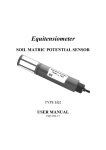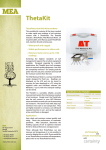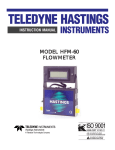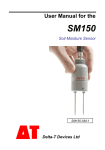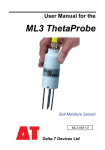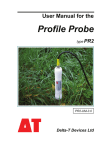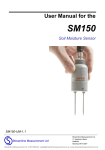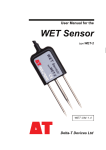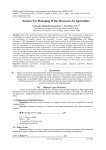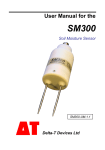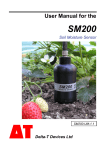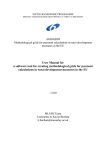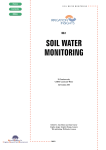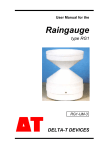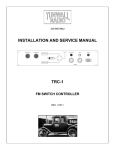Download ML2 manual
Transcript
ThetaProbe SOIL MOISTURE SENSOR TYPE ML2x USER MANUAL ML2x-UM-1.21 Contents Introduction & description .................................................................... 3 Installation .............................................................................................. 4 Wiring connections ................................................................................ 6 Connection to Delta-T data loggers (DL2 & DL3000) .......................... 7 Mechanical and electrical specifications ............................................. 8 Use and calibration ................................................................................ 9 Salinity .................................................................................................. 16 Compatibility with ThetaProbe, type ML1 .......................................... 17 Definitions............................................................................................. 20 References............................................................................................ 21 Guarantee, repairs and spares............................................................ 22 Patents The ThetaProbe has been jointly developed by The Macaulay Land Use Research Institute and Delta-T Devices and uses novel measurement techniques. They are subject to the following patents: UK - 2300485 Europe - 963703190.1 USA - 08\706675 Copyright Copyright 1999 Delta-T Devices Ltd., 128 Low Road, Burwell, Cambridge, CB5 0EJ, England. All rights reserved. Under the copyright laws this book may not be copied, in whole or in part, without the written consent of Delta-T Devices Ltd. Under the law, copying includes translation into another language. Delta-T Devices Ltd 128 Low Road, Burwell, Cambridge CB5 0EJ, England Telephone : (01638) 742922 Fax : (01638) 743155 E-mail : delta-t.co.uk ML2x-UM-1.21 May 1999 Page 2 Introduction & description The ThetaProbe measures volumetric soil moisture content, θv, by the well established method of responding to changes in the apparent dielectric constant. These changes are converted into a DC voltage, virtually proportional to soil moisture content over a wide working range. Volumetric soil moisture content is the ratio between the volume of water present and the total volume of the sample. This is a dimensionless parameter, expressed either as a percentage (%vol), or a ratio (m3.m-3). Thus 0.0 m3.m-3 corresponds to a completely dry soil, and pure water gives a reading of 1.0 m3.m-3. There are important differences between volumetric and gravimetric soil moisture contents. The section on Definitions gives details of the relationship between these two parameters and soil matric potential (as measured by Tensiometers). Operating principles ThetaProbe consists of a waterproof housing which contains the electronics, and, attached to it at one end, four sharpened stainless steel rods that are inserted into the soil. The probe generates a 100 MHz sinusoidal signal which is applied to a specially designed internal transmission line that extends into the soil by means of the array of four rods. The impedance of this array varies with the impedance of the soil, which has two components - the apparent dielectric constant and the ionic conductivity. The 100 MHz signal frequency has been chosen to minimise the effect of ionic conductivity, so that changes in the transmission line impedance are dependent almost solely on the soil's apparent dielectric constant. Because the dielectric of water (~81) is very much higher than soil (typically 3 to 5) and air (1), the dielectric constant of soil is determined primarily by its water content. The impedance of the rod array affects the reflection of the 100 MHz signal, and these reflections combine with the applied signal to form a voltage standing wave along the transmission line. The output of the ThetaProbe is an analogue voltage proportional to the difference in amplitude of this standing wave at two points, and this forms a sensitive and precise measure of soil water content. Work published over many years by Whalley, White, Knight Zegelin and Topp and others, shows almost linear correlation between the square root of the dielectric constant, ( √ε ), and volumetric moisture content, (θv), and this has been documented for many soil types. Each ThetaProbe is adjusted during manufacture to provide a consistent output when measuring media of known dielectric constant, making them readily interchangeable without system re-calibration. The output signal is 0 to1V DC for a range of soil dielectric constant, ε, between 1 and 32, which corresponds to approximately 0.5 m3.m-3 volumetric soil moisture content for mineral soils. Page 3 ML2x-UM-1.21 May 1999 Installation Essentially installation is very simple - you just push the probe into the soil until the rods are fully covered, connect up the power supply and take readings from the analogue output. Optional extension tubes are available for monitoring a soil layer below the surface. However, it is quite possible to get sampling errors greater than 0.1 m3.m-3, and in extreme cases damage the probe if you don't pay due care and attention to the details of the installation of ThetaProbes when making measurements of soil water content. You will need to consider each of the following factors when setting up a measurement: Air pockets The ThetaProbe is sensitive to the water content of the soil sample held within its array of 4 stainless steel rods, but this sensitivity is biased towards the central rod and falls off towards the outside of this cylindrical sampling volume. The presence of air pockets around the rods, particularly around the central rod, will reduce the value of soil moisture content measured. In particular, you need to be very careful when removing and re-inserting the probe into a previous location. Insertion angle If the probe is going to be left in situ, and measurements taken during and after rainfall, it is a good idea to insert it at an angle (say 20°), so that any water running down the side of the probe housing tends to be carried away from the rods. This is particularly important if the probe is being installed below the soil surface using a probe extension tube. Soil sampling points The soil water content measured by a ThetaProbe within one small locality can be affected by : Variations in soil density and composition, Stones close to the rods, Roots (either nearby or pierced by the rods), Earth worm holes (or even mole holes!), Subsoil drainage, Small scale variability in transpiration and evaporation losses. It is important to take the degree of variability of these various parameters into account when deciding on the number of probes to use at any particular location. If the soil is known to be very heterogeneous, it will be necessary to take measurements from at least three closely-spaced locations. Care and maintenance ThetaProbes are sealed after calibration, require no routine maintenance and are constructed of materials selected for robust field operation. However, please pay careful attention to the following 3 points: 1. Do not remove the cross-head sealing screws. This may damage the seal and will invalidate your guarantee. No internal maintenance or repair can be performed by the user. 2. Do not remove the ThetaProbe from soil by pulling on the cable. ML2x-UM-1.21 May 1999 Page 4 If the measurement rods become bent in use, they can be carefully unscrewed from the body and straightened. They have a right-handed thread. 3. Do not attempt to straighten the measurement rods while they are still attached to the probe body. This may break the rods or damage the case seal. Even a small degree of bending in the rods (>1mm out of parallel), although not enough to affect the inherent ThetaProbe accuracy, will increase the likelihood of air pockets around the rods during insertion, and so should be avoided. Replacements rods are available if required (type ML-RODS). Ensure that they are fully tightened on reassembly, but do not apply excessive force, as this will cause damage to the probe body seal. Pre-preparation of holes to accept ThetaProbe measuring rods is recommended in stony soils or other hard materials. Extension tubes. The probe is designed to be permanently buried, if required. When used like this, optional extension tubes can be fitted to enable easier withdrawal, and to protect the cable from damage by animals, etc. Extension tubes are lengths of the same tubing as is used to make the ThetaProbe cylindrical body. They have a female thread in one end and the same sized male thread in the other. Two lengths are available. ML/EX50 is 50cms long and ML/EX100 is 100cms long. These can be screwed into each other to make longer lengths, as required. Extension tubes allow the ThetaProbe to be lowered into pre-augured holes down to the desired measurement depth, and to ease removal from the soil when the application requires burial. The outside diameter of the extension tubes is 4cms, so an auger of approximately 5cms is recommended. Extension tubes can be easily added to the ThetaProbe by following these instructions: Carefully remove the black plastic, thread protection cover from the ThetaProbe. This cover protects the extension tube mating thread when extension tubes are not needed. It can be removed by sliding it up the cable. Pass the ThetaProbe cable through the hole in the extension tube, ensuring that the female thread in the extension tube is towards ThetaProbe. Screw the extension tube onto ThetaProbe and hand tighten only. Repeat this process for additional extension tubes to make up the length required. Finally, thread the cable through the black plastic thread protection cover and slide the cover into place over the male thread on the end of the extension tube. This will minimise water ingress into the tube. Page 5 ML2x-UM-1.21 May 1999 Wiring connections ThetaProbe is supplied with a four core, screened cable which provides these connections: Red Power supply positive. Blue Power supply zero volts. Yellow Output signal HI, load resistance 10KΩ minimum. Green Output signal LO. Braid Cable screen. Not connected within probe. The Blue and Green leads are connected internally. The braid screen should be connected to an analogue earth on the logger or other measuring unit. If not using Delta-T equipment, please refer to the manufacturer's instructions. Some ThetaProbe variants have or require a connector to be fitted to mate to appropriate Delta-T instrumentation. Connection details are given in the relevant instrumentation User Manual. Electromagnetic Compatibility ( EMC ) ThetaProbe has been assessed for compatibility under the European Union EMC Directive 89/336/EEC and conforms to the appropriate standards, provided the moisture measuring rods and probe body are completely immersed in the soil or other material being measured. The cable connecting the ThetaProbe to its associated instrumentation should also be routed along the surface of the soil. If the probe is not installed in this way, some interference may be experienced on nearby radio equipment. Under most conditions, moving the equipment further from ThetaProbe (typically 1-2 metres) will stop the interference. ThetaProbes installed near to each other will not malfunction due to interference. ML2x-UM-1.21 May 1999 Page 6 Connection to Delta-T data loggers (DL2 & DL3000) Power Connections ThetaProbe can be directly powered by Delta-T data loggers using their internal batteries. However, if several probes are to be used, or if the logger has to supply significant power to other sensors or accessories, we recommend powering the logger and sensors from an external power supply. Battery power consumed by a probe for a single measurement taken with a 1 second warm-up time is typically: 19mA * 1s ≅ 0.005 mA.h Delta-T loggers include a minimum of two relay controlled outputs to provide and control sensor power. Each relay ( called a warm-up relay ) is capable of switching 1A. This means that each relay can typically power 50 ThetaProbes. Configuring the Warm-up Channel Although the probe can be continuously powered and read, significant power can be saved by using the Delta-T logger warm-up relay facility to energise the sensor only just before and during a log. For complete stability, a warm-up time of 5s is recommended, although good repeatability can be achieved using times down to 1s (the additional error associated with a 1 second warm-up is only ±0.0025 m3.m-3). Shorter times will significantly reduce the battery power consumption of the system. Logger input channel configuration ThetaProbe has been designed to make its use with dataloggers straightforward, using only a single logger analogue input channel. If you simply want to log the probe voltage directly, it should be treated as a differential voltage source of range 0-1.5VDC, and the logger should be configured accordingly. You can convert the data to soil moisture units after logging, using the information supplied in the Calibration section. The Calibration section also describes how to program your datalogger to automatically convert probe output into soil moisture units before logging. DL2e connection and configuration This diagram shows the connections for a ThetaProbe connected to channel 1 of a DL2e in differential mode, and powered through the loggers internal power supply. Further details can be found in the SENSORS.TXT file which is supplied with the DL2e sensor library codes for the ThetaProbe, and in the DL2e manual section on Relay Channels. Two sensor configuration codes are supplied with the DL2e: M2M which provides generalised conversion from mVolts to volumetric soil water content (in m3.m-3) suitable for generalised mineral soils, and M2O, which is suitable for generalised organic soils. DL3000 connection and configuration Full details, including example connection diagrams, are available in the on-line Help provided with Acquire!. Page 7 ML2x-UM-1.21 May 1999 Mechanical and electrical specifications (dimensions in mm) Technical Specifications Type No. ML2x Measurement parameter Volumetric soil moisture content, θV (m3.m-3 or %vol.). Range Accuracy figures apply from 0.05 to 0.6 m3.m-3, Full range is from 0.0 to 1.0 m3.m-3 Accuracy ±0.01 m3.m-3, 0 to 40°C, ±0.02 m .m , 40 to 70°C, 3 -3 after calibration to a specific soil type subject to soil salinity errors, see below ±0.05 m3.m-3, 0 to 70°C Soil salinity errors 0.0 to 250 mS.m-1, < -0.0001 m3.m-3 change per mS.m-1, using the supplied soil calibration, in all 'normal' soils, 250 to 2000 mS.m-1, no significant change. Soil sampling volume >95% influence within cylinder of 4.0cm diam., 6cm long, (approx 75 cm3 ), surrounding central rod. Environment Will withstand burial in wide ranging soil types or water for long periods without malfunction or corrosion (IP68 to 5m) Stabilization time 1 to 5 sec. from power-up, depending on accuracy required. Response time Less than 0.5 sec. to 99% of change. Duty cycle 100 % ( Continuous operation possible ). Interface Input requirements: 5-15V DC unregulated. Current consumption: 19mA typical, 23mA max. Output signal: approx. 0-1V DC for 0-0.5m3m-3 Case material PVC Rod material Stainless steel Cable length Standard: 5m. Weight 350 gm approx. with 5m cable. ML2x-UM-1.21 May 1999 Maximum length: 100m Page 8 Use and calibration ThetaProbe can be used to provide an instantaneous reading of soil conditions or, in conjunction with a datalogger, comprehensive moisture data over time. The millivolt output from the probe, although requiring a non-linear conversion to soil moisture units for optimum accuracy, can provide reasonable results using a straightforward linear conversion. To use the probe without a datalogger, you will need to provide it with 5-15VDC at about 20mA. Voltage readings can be taken with any general purpose voltmeter and the conversion to soil moisture units made using the information given in a later section. This measurement method produces good, instantaneous results easily, but for optimum accuracy, automatic conversion to soil moisture units for known types of soil and, of course, permanent data records, ThetaProbe should be used with a datalogger. Data conversion methods Every ThetaProbe uses the same characteristic to convert from its mV output to the square root of the apparent dielectric constant,√ε, of the soil. However, the conversion from √ε to percent moisture content depends on the soil type encountered. If you want to log data in soil moisture content units, you will have to provide the logger with information about how to convert the data. Three main methods of configuring dataloggers to ThetaProbe are recommended: • Polynomial equation conversion. • Linearisation table conversion. • Slope and offset conversion. Each method is described in the following section. The need for calibration The relationship beween ThetaProbe output and soil moisture content is a non-linear curve of this form: θ v for generalised mineral and organic soils 1.000 0.900 organic mineral soil moisture (m3.m-3) 0.800 0.700 0.600 0.500 0.400 0.300 0.200 0.100 0.000 0 0.2 0.4 0.6 0.8 1 1.2 ThetaProbe output (V) Page 9 ML2x-UM-1.21 May 1999 These two curves are generalised examples for mineral and organic soils. The calibration curve for any specific soil would be slightly different from either of these because the ThetaProbe is actually sensing the dielectric constant, (ε) of the soil, and the relationship between the measured dielectric constant of a soil and its water content (θ) depends on the particular composition of the soil. You will need to calibrate the ThetaProbe for your specific soil if you want to minimise the errors associated with converting the ThetaProbe output (V) to soil water content. The repeatability of the ML2x is ±0.01 m3.m-3 (from 0 to 40°C) . Theoretically, if a soil specific calibration is performed with no additional errors, this will be the probe error in this situation. If using a generalised calibration, typical errors of ±0.05 m3.m-3 should be expected. In practice, whether you need to do a soil-specific calibration will depend on what accuracy you need to work to and the size of your sampling errors (see section on “Achievable Accuracy”). Response to dielectric constant Performing a soil-specific calibration is relatively straightforward, because all ML2x ThetaProbes respond to dielectric constant in the same stable, uniform way, so it is only necessary to do this once for one probe. The relationship beween ThetaProbe output, (V), and square root of dieletric constant, (√ε), is like this: 6.00 5.00 √ε 4.00 √ε 3.00 polynomial linear 2.00 1.00 0.00 0 0.1 0.2 0.3 0.4 0.5 0.6 0.7 0.8 0.9 1 ThetaProbe output (V) In the range 0 to 1 Volt (corresponding to a soil moisture range 0 to ~ 0.55 by volume), this relationship can be fitted very precisely by a 3rd order polynomial: ε = 1.07 + 6.4V − 6.4V 2 + 4.7V 3 (R2 = 0.998) [1] (R2 = 0.99) [2] or by the linear relationship: ε = 11 . + 4.44V ML2x-UM-1.21 May 1999 Page 10 Our experience of measurements on soils suggests that below 0.5 m3.m-3 there is no significant improvement to the overall accuracy to be achieved by using the 3rd order polynomial equation rather than the linear relationship. For very high moisture contents (θ > 0.5 m3.m-3), the polynomial equation should be used. This is usually only necessary for organic soils. Soil-specific Calibration Whalley, and White, Knight, Zeggelin and Topp have shown that there is a simple linear relationship beween the complex refractive index (which is equivalent to √ε), and volumetric water content, θ, of the form: ε = a 0 + a1 ⋅ θ [3] Since the relationship beween ThetaProbe output and √ε is already known, it is only necessary to determine the two coefficients, a0 and a1. We suggest you use the following protocol: Step 1 Collect a sample of damp soil, disturbing it as little as possible so that it is at the same density as in situ. Insert the ThetaProbe into the sample and measure the probe output, Vw. εw . Use equation [1] or [2] to calculate Weigh the damp sample, (Ww), and measure its volume (L). Step 2 Oven-dry the sample, insert the ThetaProbe into the dry soil (θ ≈ 0), and measure the probe output, V0. Weigh the dry sample, (W0). Use equation [1] or [2] to calculate This equals a0. It will usually have a value between 1.0 and 2.0. Step 3 ε 0. Calculate the volumetric water content θ w of the original sample: θw = Step 4 Then (Ww − W0 ) L εw − ε0 . θw a1 = [4] It will usually have a value between 7.6 and 8.6. Step 5 By inverting equation [3], and substituting from equation [2], the water content determined from a calibrated ThetaProbe will then be: θ= [11. + 4.44V ] − a 0 [5] a1 The corresponding equation using the polynomial relationship is: [1.07 + 6.4V − 6.4V θ= a1 Page 11 2 ] + 4.7V 3 − a 0 [6] ML2x-UM-1.21 May 1999 Using this relationship (rather than the linear form) will enable the ThetaProbe to achieve full accuracy over the full specified range, particularly for wetter soils with 0.5 < θ < 0.6. Example: 1. In a sample of moist soil, the ThetaProbe gives an output of 0.43 V. This sample weighs 1.18, and has a volume of 0.75 litres. From equation [1], ε w = 3.01 2. After drying the sample of soil, the ThetaProbe gives an output of 0.11 V. From equation [1] again, we can calculate a0 = ε 0 = 1.59. 3. The dry sample now weighs 1.05 kg, so the volume of water in the moist sample was 0.13 litres. Volumetric water content of the sample θ w = 0.173 m3.m-3. 4. By substituting in equation [4], a1 = 8.19 5. Finally, by inserting into equation [5], θ V = 0.54V - 0.060 m3.m-3 Note: It is important to use either the polynomial relationships (equations [1] and [6]), or the linear relationships (equations [2] and [5]) consistently when deriving and using the coefficients a0 and a1. In the above example the coefficients have been derived using the linear relationship in equation [2], so equation [5] and not equation [6], must be used for generating the conversion formula. ML2x-UM-1.21 May 1999 Page 12 Generalised calibration If it is not necessary to perform a soil-specific calibration, we suggest using the following parameters which have been derived from the measurements taken on a large number of mineral and organic soils: a0 a1 Mineral soils 1.6 8.4 Organic soils 1.3 7.7 These parameters have been used to generate the following linearisation tables and slope and offset conversions: Linearisation table conversion Delta-T dataloggers are able to store a linear or non-linear conversion characteristic permanently in their software using a linearisation table. This enables almost instantaneous logger channel configuration. All that is required is to select a Sensor Type code number from a list displayed on your computer screen. For users of existing Delta-T dataloggers, you can add the necessary linearisation tables using the following data: soil moisture θv, m3.m-3 -0.05 0 0.05 0.1 0.15 0.2 0.25 0.3 0.35 0.4 0.45 0.5 mV, organic soil mV, mineral soil -2090 40 110 192 283 400 500 600 700 780 850 920 -2090 90 170 280 400 510 620 720 810 880 940 1000 soil moisture θv, m3.m-3 0.55 0.6 0.65 0.7 0.75 0.8 0.85 0.9 0.95 1.0 1.05 mV, organic soil mV, mineral soil 970 1010 1025 1045 1060 1070 1080 1090 1100 1110 2090 1020 1045 1055 1065 1070 1080 1085 1090 1100 1110 2090 For details of how to do this, refer to your Datalogger User Manual. Use of this feature will give improved accuracy and give indicative moisture readings at high moisture levels. Note that non-linearity has been introduced at both ends of the table to avoid ‘out of range’ logged readings outside of the probes valid working range. Slope and offset conversion. Using linear - fit equations from experimental data, offset and slope parameters have been calculated that can be programmed into any data logger capable of accepting this conversion method. For details of how to do this, refer to your data logger Page 13 ML2x-UM-1.21 May 1999 documentation. Delta-T loggers can be programmed in this way if preferred, although linearisation tables are capable of achieving higher accuracy. For DL2 AND DL2e loggers, the ‘Engineering Factor’ used for slope conversion is the reciprocal of the ‘Slope’ figures below. This conversion method applies to a probe output range of 0-900mV, beyond which the output becomes excessively non-linear. The parameters to convert from probe output in mV to organic and mineral % moisture content for soils are: From probe mV to: Slope Offset % moisture, Mineral soil 0.050 -5.0 % moisture, Organic soil 0.055 -2.0 Organic and Mineral definitions: The generalised calibrations have been optimised to cover a wide range of soil types, based on the following definitions: Soil type optimised around organic content: use for organic contents: bulk density range (g.cm-3): use for bulk densities Mineral ~ 1 %C < 7 %C 1.25 - 1.5 g.cm-3 > 1.0 g.cm-3 Organic ~ 40 %C > 7 %C 0.2 - 0.7 g.cm-3 < 1.0 g.cm-3 ML2x-UM-1.21 May 1999 Page 14 Achievable accuracy The errors associated with the ThetaProbe are shown in the Specifications table. They are the errors associated with the instrument itself, and don’t take into account errors you may introduce when carrying out a calibration, and they assume you insert the probe perfectly into a perfectly uniform material. They assume an error budget like this: Error category soilspecific calibration generalised calibration source of error ThetaProbe errors ± 0.01 ± 0.01 repeatability beween ML2x probes Calibration errors ± 0.00 ± 0.04 typical error in values of a0 and a1 Overall error ± 0.01 ± 0.05 (RSS value) In practice, when determining the overall reading errors, sampling and insertion errors need to be considered. As described in the Installation section, these can be as large as 0.1 m3.m-3. With care and by taking appropriate numbers of samples (10 to 20 samples might be required for each reading), you may reduce this, but unless your soil is unusually homogeneous, these errors are unlikely to be less than 0.04 m3.m-3. Based on that, you might expect the errors associated with your readings to look like this example (values are m3.m-3): Error category soilspecific calibration generalised calibration source of error ThetaProbe errors ± 0.01 ± 0.01 repeatability beween ML2x probes Calibration errors ± 0.02 ± 0.04 errors in values of a0 and a1 Sampling errors ± 0.04 ± 0.04 soil variability and insertion errors Overall error ± 0.05 ± 0.06 (RSS value) If a linear, rather than Linearisation Table or polynomial conversion is used, the following additional error will apply, resulting in the overall error shown. Linearity errors ± 0.015 ± 0.015 if linear rather than polynomial conversion used (0 to 900mV) Overall error ~ ± 0.05 ~ ± 0.06 (RSS value) It should be emphasised that these figures are given purely for illustration purposes - the actual accuracy achieved in a particular measurement will depend mainly on Page 15 • soil heterogeneity, • the number of samples taken, • the extent to which it is possible to perform an accurate calibration on an “undisturbed” sample, • inserting the ThetaProbe without causing air pockets or localised soil compression. ML2x-UM-1.21 May 1999 Salinity The output of the ThetaProbe is affected by the ionic conductivity of salts dissolved in the soil moisture. This effect is not major, and is limited to salinity levels below about 250 mS.m-1. The potential error is discussed below. Units The preferred units for ionic conductivity units are mS.m-1 (where S is Siemens, a measure of electric conductance). The following conversions apply: 1 mS.m-1 = 0.01 mS.cm-1 = 0.001 mmho.cm-1 = 10 µS.cm-1 Soil salinity is also partitioned into the following descriptive categories: 0 - 200 mS.m-1 slightly saline 200 - 400 mS.m-1 moderately saline 400 - 800 mS.m-1 strongly saline 800 - 1600 mS.m-1 extremely saline > 1600 mS.m-1 non-saline ThetaProbe response The ThetaProbe has been tested extensively in saline conditions, both in fluids and soils (even up to 6000 mS.m-1!). The response in water of varying salinity is as follows: MLURI conductivity data 1.2 ThetaProbe output (V) 1 0.8 Vmeasured 0.6 0.4 0.2 0 0 500 1000 1500 2000 2500 Ionic conductivity,==σ (mS.m ) -1 This response (in aqueous solutions) is accurately characterised by the following equation: V( σ =σ ′ ) = V(σ =0 ) (1 + b0 (1 − e b1⋅σ ′ )) , where b0 ≈ 0175 . , and b1 ≈ −0.0038 , and σ is in mS.m-1. [7] The response to changes in salinity for soils (at fractional volumetric water contents less than 0.6 m3.m-3) has been shown to be correspondingly less, but is difficult to quantify ML2x-UM-1.21 May 1999 Page 16 accurately. We believe from the data available that the response curve follows the same general shape, and that the values for b0 and b1 are similar. Effect on the apparent soil moisture There are two important simplifications to note as a result of the above response curve: 1. You can ignore salinity effects for soils that are known to be moderately saline or strongly saline (i.e. 400 <=σ < 1600 mS.m-1) provided you have performed a soil-specific calibration. 2. Changes in salinity due solely to drying/wetting cycles do not significantly affect readings. The worst case situation occurs when a non-saline soil is irrigated with saline irrigation water, i.e when a calibration is carried out on a non-saline soil sample (giving values for the coefficients a0 and a1, as in the previous section), but the actual measurement is made on a sample with significant salinity. As an indication of the size of the possible errors, we will assume that equation [7] above is generally applicable to soils, and combine this with equations [2] and [3] to give: V = a 0 + a1 .θ − 11 . [ ( 4.44 1 + b0 1 − e b1 ⋅σ )] [8] For example, suppose a calibration has determined that the coefficients for a0 and a1 should be 1.5 and 7.8, and a reading of 0.71Volts is obtained with the ThetaProbe. If it was assumed that the salinity was σ ′ = 0.0 mS.m-1, the soil moisture content calculated from equation [8] would be θ ′ = 0.35 m3.m-3. However, if the sample’s salinity was in fact σ ′′ = 100.0 mS.m-1, the real moisture content would have been θ ′′ = 0.37 m3.m-3, resulting in an error of 0.02 m3.m-3. Minimising errors due to salinity Calibrate the ThetaProbe in a sample of soil which is towards the lower end of (but not below) the range of salinities that are likely to be encountered. If you are using the ThetaProbe in situations where the salinity varies widely and includes non-saline conditions, you may need to measure the salinity and then apply a correction using equation [8]. Compatibility with ThetaProbe, type ML1 Page 17 ML2x-UM-1.21 May 1999 ML2 output compared to ML1 6.00 5.00 √ε 4.00 3.00 ML1 ML2 2.00 1.00 0.00 0 0.1 0.2 0.3 0.4 0.5 0.6 0.7 0.8 0.9 1 output (V) The ML2x performs very similarly to the previous version of the ThetaProbe, the ML1. This graph shows a comparison of their response to dielectric constant. These differences beween the ML1 and ML2x result in very slightly different values of a0 and a1 when doing a soil-specific calibration (see below). When the differences in a0 and a1 are allowed for, the measurements of soil moisture can differ by up to 0.025 m3.m-3. Adapting ML1 calibrations for ML2x If you’ve done a soil specific calibration with the ML1, and generated values of a0(ML1) and a1(ML1), those values should be unchanged when used with the ML2x, because they describe the dielectric properties of the soil (see equation [3]), and are theoretically independent of the response of the ThetaProbe. However the changes to the nature of the curve (or linearisation) used to model the response of the ThetaProbe does have a slight effect on the calculated values of a0 and a1, and so you may choose to use slightly different values, a0(ML2) and a1(ML2), for the ML2x. • for maximum compatibility with ML1 readings, use: • for greatest accuracy ML2x-UM-1.21 May 1999 mineral soils: no change. organic soils: a 0( ML 2 ) = a 0( ML1) , a1( ML 2 ) = a1( ML1) − 01 . generate new values of a0 and a1 using the ML2x and following the procedure on page 11. Page 18 Mixed installations of ML1 and ML2x ThetaProbes If you have a mixture of ML1 and ML2x ThetaProbes in an installation, obviously the best choice is to use ML1 calibrations for the ML1 and ML2x calibrations for the ML2x. Sometimes that will be impractical, and you need to know whether it’s possible to use both ML2x and ML1 with the same conversion. If you do, there will be an extra source of errors in the errors table, and the overall reading errors will typically increase by 0.01 m3.m-3, as in this rework of the example in the section on Acieveable Accuracy. Error category soilspecific calibration generalised calibration source of error ThetaProbe errors ± 0.01 ± 0.01 repeatability beween ML2x probes compatibility errors ± 0.025 ± 0.025 max. differences beween ML2x and ML1 probes (non-random error) Calibration errors ± 0.02 ± 0.04 errors in values of a0 and a1 Sampling errors ± 0.04 ± 0.04 soil variability and insertion errors Overall error ~ ± 0.06 ~ ± 0.07 (RSS value) Using the ML2x with the ThetaMeter, type HH1 The ThetaMeter is optimised for use with the ML1 rather than the ML2x. It is compatible with the ML2x, and the mVolt readings will be accurate, but the mineral and organic conversions use the old ML1 values for slope and offset. The effect of this is to add approximately 0.01 m3.m-3 error to the readings, as in the example above. This can probably be ignored for the general purpose use for which the ThetaMeter was intended. Page 19 ML2x-UM-1.21 May 1999 Definitions Volumetric Soil Moisture Content is defined as θV = VW VS where Vw is the volume of water contained in the sample, and Vs is the total volume of the soil sample. The preferred units for this ratio are m3.m-3, though %vol is also frequently used. The usefulness of this definition depends in part on the fact that the volume of the dry soil does not change as water is added. This is not true of shrink-swell soils, but for the most part is a reasonable approximation. Soil Moisture Content varies from approx. 0.02 m3.m-3 for sandy soils at the permanent wilting point, through approx. 0.5 m3.m-3 for clay soils at their field capacity, up to values as high as 0.85 m3.m-3 in saturated peat soils. Soil water content is usually expressed volumetrically, because it is then possible to ignore the bulk density of the soil sample. Volumetric versus Gravimetric soil water content Gravimetric Soil Moisture Content is defined as θG = MW MS g.g-1 where MW is the mass of water in the sample, and M S is the total mass of the dry sample. To convert from volumetric to gravimetric water content, use the equation θ G = θV * ρW ρS where ρW is the density of water (= 1), and ρ S is the bulk density of the soil sample ( = MS ). VS Soil Water Content versus Soil Matric Potential Studies of plant growth need to characterise the availability of water to the plant, and this is usually done using the soil matric potential, φw, which measures the suction necessary to extract a unit voume of water from the soil pores, and is measured in units of pressure, hPa. The soil matric potential is highly dependent on both soil type and soil water content, and varies from 0 hPa at field capacity, down to approximately -1500 hPa at the permanent wilting point. The relationship beween soil water content (θv) and soil matric potential (φw) is called the water release curve (or characteristic, or retention curve), and varies greatly for different soil types. There is no generalised method of converting from soil water content to matric potential, though a number of expressions have been found which have been successfully applied to a restricted list of soil types. ML2x-UM-1.21 May 1999 Page 20 References 1. Gaskin, G.J. and Miller, J.D. 1996 Measurement of soil water content using a simplified impedance measuring technique. J. Agr. Engng Res 63, 153-160 2. Topp, G. C., J. L. Davis, A. P Annan 1980 Electromagnetic determination of soil water content Water Resour. Res 16(3) 574-582 3. Whalley, W R 1993 Considerations on the use of time-domain reflectometry (TDR) for measuring soil moisture content. Journal of Soil Sci. 44, 1-9 4. White, I, Knight, J H, Zegelin, S J, and Topp, G C 1994 Comments on ‘Considerations on the use of time-domain reflectometry (TDR) for measuring soil water content’ by W R Whalley Journal of Soil Sci. 45, 503-508 5. Roth, C H, Malicki, M A,and Plagge, R. 1992 Empirical evaluation of the relationship between soil dielectric constant and volumetric water content as the basis for calibrating soil moisture measurements. Journal of Soil Sci. 43, 1-13 6. Page 21 Knight, J.H. 1992 Sensitivity of Time Domain Reflectometry measurements to lateral variations in soil water content. ML2x-UM-1.21 May 1999 Guarantee, repairs and spares Our Conditions of Sale ref: COND/91/11 set out Delta-T's legal obligations on these matters. For your information the following paragraphs summarise Delta-T's position but reference should always be made to our Conditions of Sale which prevail over the following explanation. Instruments supplied by Delta-T are guaranteed for one year against defects in manufacture or materials used. The guarantee does not cover damage through misuse or inexpert servicing, or other circumstances beyond our control. For the UK this means that no charges are made for labour, materials or return carriage for guarantee repairs. For other countries, the guarantee covers free exchange of faulty parts during the guarantee period. Alternatively, if the equipment is returned to us for guarantee repair, we make no charge for labour or materials but we do charge for carriage and UK. customs clearance. We strongly prefer to have such repairs discussed with us first, and if we agree that the equipment does need to be returned, we may at our discretion waive these charges. Service and spares We recognise that some users of our instruments may not have easy access to technically specialised backup. Please refer to the Care and Maintenance section of this Manual for specific information on this product. Spare parts for our own repairable instruments can be supplied from our works. These can normally be despatched within 1 working day of receiving an order. Spare parts and accessories for sensors not manufactured by Delta T, but supplied by us individually or as part of the weather station or other system, may be obtained from the original manufacturer. We will endeavour to obtain parts if requested, but a certain amount of additional delay is inevitable. Should it prove necessary, instruments may be returned to our works for servicing. We normally expect to complete repairs of our own instruments within 2 days of receiving the equipment. Other manufacturers' sensors supplied by us and returned for servicing will take longer. They will have to be returned to the original manufacture for servicing, and may be subject to additional delays of two to four weeks. Users in countries that have a Delta-T Agent or Technical Representative should contact them in the first instance. ML2x-UM-1.21 May 1999 Page 22






















